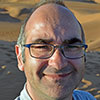Taking advantage of a respite from the eruption of Goðasteinn (that’s the name of the volcano lying underneath the Eyjafjallajökull glacier – jökull meaning glacier), last month research curator Brian Jackson and I were finally able to fly to Iceland, arriving on 12 June at Keflavik airport, southwest of Reykjavik, for a six-day expedition.
The trip had been planned for a long time but was unfortunately delayed by the long Icelandic winter, and the recent eruption that disrupted the air traffic across Europe.
The aim of the trip was to select and collect a large specimen of ropy lava (aka pahoehoe lava) for display in the forthcoming Royal Museum Project gallery, Restless Earth.
Our contacts were Dr Ármann Höskuldsson from the University of Iceland and Dr Kristján Jónasson from the Natural History Museum in Reykjavik. Dr Jónasson’s expertise of the local geology was very useful, and he kindly led us in the field in search of the ideal specimen.
We visited many sites around Reykjavik and ear-marked several possible options. However, one other locality in the southwest of Iceland needed to be visited, and it is about five hours’ drive from the capital city. Unfortunately our guest couldn’t accompany us there but gave a rough indication on a map of where to search – the search area covering more than five kilometres! We decided to dedicate two days for this trip, with an overnight stay around Skaftafell.

On arrival we scanned the search area, pinpointing the different options. By the end of the afternoon we had found the ideal specimen, but it was half-buried in sand. However, its recovery will be straightforward as it is naturally pre-cut and very close to the main road. Dr Jónasson, who also delivers permits for collecting and exporting, will help with the recovery, the crating, and the shipping of the specimen.

The chosen specimen shows a combination of beautiful ropy structure with relatively well-preserved sheen crust and smooth surface. Additionally, the story behind the eruption that produced this specimen is very interesting … but you will all have to wait until the opening of the new galleries next year to read about it.
